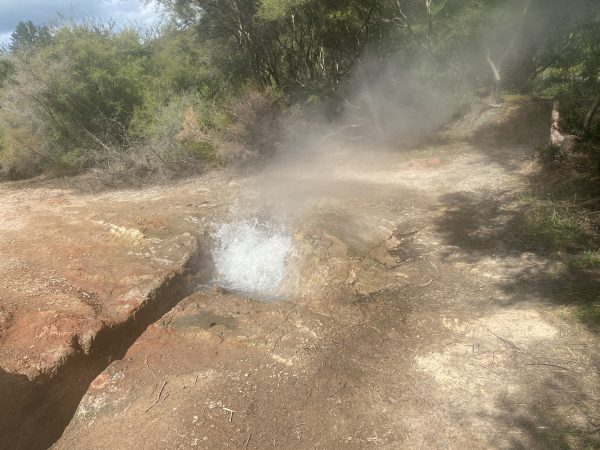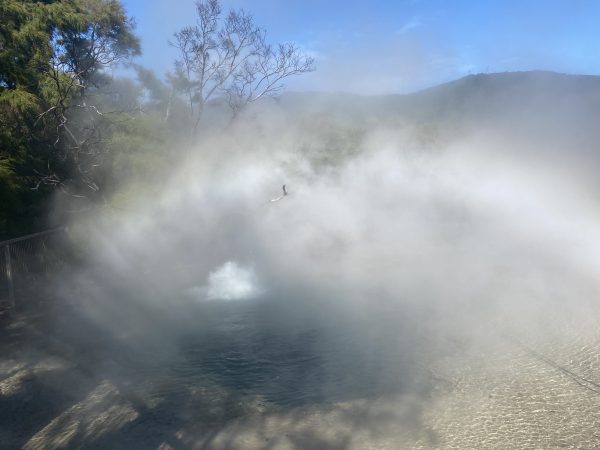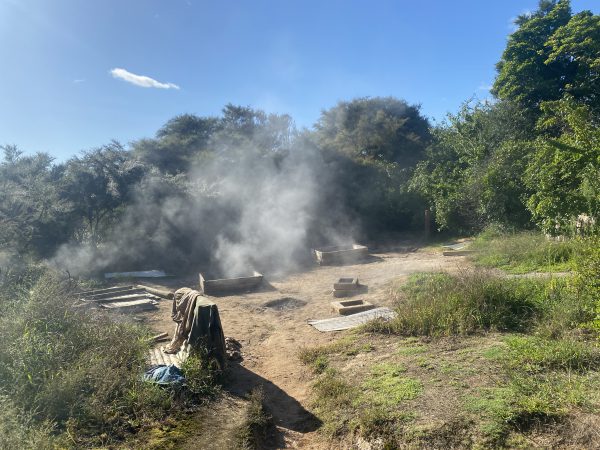Posted on
Tag: Tokaanu
Posted on
Posted on
Puanga & Mangaroa St. Features, Tokaanu, New Zealand
Video by H.Koenig
Posted on
Hoani, Tokaanu, New Zealand
Posted on
Observations for 2023 March 04
It was cool and damp when we arrived at Tokaanu. Before going into the Reserve proper, we investigated the features across the road. There we could hear, hidden in the bush, the sounds of splashing. Along the street, there were areas of hot ground, including a spot between the curbstones where a frying pan was forming.
Went into the reserve, and almost immediately things didn't look good. There were two vehicles parked exactly at the spot where there's a gap in the fence to get to Taumatapuhipuhi. On the back of the flatbed truck was a dog that loudly objected my presence anywhere while I was within sight. It barked continuously for several minutes. At one point I heard an eruption hidden by the vehicles, which I assume was Taumatapuhipuhi. I finally decided to walk the loop taking videos and then decide what to do.
As I neared the finish of the loop, I heard the vehicles leave. The way to Taumatapuhipuhi was now open. As it turned out, I heard them leave as I was passing a feature that would become a center of attention during our visit, and so I didn't pay as much attention to that feature as I should have.
Was able to log the times for eight consecutive eruptions of Taumatapuhipuhi, starting with the one I heard. The intervals started long. We had to wait almost 36 minutes to see the eruption after the one I heard. From then on, the intervals decreased so that the last interval we saw was 21 minutes. Because of this, we did miss a couple of the eruptions. The first time that happened, we walked up to see the sinter platform wet and steaming. The second time I did get an "in eruption" time.
The durations of the eruptions varied from 26 to 10 seconds, with the other three durations being about 20 seconds. The heights were about two meters, and wide. I got splashed once standing about three meters from the rim.
The reason we missed eruptions was because we discovered another erupting feature. Named Hoani, it is a wide, deep boiling pool. The central pit was about five meters across, and I could not see any bottom to it. It is located in a broad, tannish colored sinter sheet depression.
When I walked by taking a video, and the video shows that it was quite hot, and full to the rim. I didn't remember any such feature from our visit four years ago. After the first eruption of Taumatapuhipuhi finished, we decided to head back to look at a few features along the trail, and immediately noticed the 30-40cm high boiling on one side of the crater. This boiling built up to well over a meter, then subsided. This activity continued for at least 1h15m, and we probably saw it near the start. At one point, I saw some surges that could have been two meters high. The activity was much like Artemisia.
The walkway was not built with an erupting, boiling spring in mind. There were times when I was walking along that the fog from the eruption was almost scaldingly hot. This steam was condensing on some of the trees, producing a rain below them. We tried to time our visits to Taumatapuhipuhi and spend rest of the time at Hoani, which is why we missed a couple of Taumatapuhipuhi eruptions.
It was after one of those eruptions that we noticed that the pool was quiet again. Previous pauses had lasted only a few seconds, but this one stretched into a minute or more. Then we noticed that the pool was dropping. By the time we left the area, 45 minutes later, Hoani was down 30-40cm, with the outer rim already drying in spots.
Beyond Taumatapuhipuhi is an area that's been heavily "culturally modified." An area of hot ground and frying pans that's been converted into an area for the preparation of hangi, the Maori method of cooking in hot ground.
After almost four hours at Tokaanu, we headed towards Rotorua. There were a couple of minor thermal areas north of Taupo that we had not visited the last time that we were going to try to see.
The first was "Craters of the Moon", where the Karapiti Blowhole was located. The area has been heavily affected by the nearby geothermal powerplants, and consists mostly of subsidence craters with some weak fumaroles scattered about. The only feature of any interest is the replacement for Karapiti, which is up on a hillside and consists of a wet, moderately noisy fumarole and some other noisy fumaroles. This of "A Fumarole" at Fountain Paint Pots.
This area can be bypassed unless you want to see what a destroyed thermal area looks like, or want to complete a checklist.
The second stop was going to be the "Wairakei Thermal Valley". This is an area that used to contain close to a hundred geysers, some playing to over 30 meters. It is now completely overgrown because all the activity has gone into making electric power. Was not looking forward to visiting, but figured should at least see what it looked like. But when we got to the entrance road, we were blocked by a closed sign. In the Taupo area the cyclone of a few weeks earlier had destroyed a significant percentage of the trees in the area. A lot of those trees had their tops snapped off, while others were complete uprooted.
(Earlier in the week, near Tongario National Park, we had to lengthen our hike to a waterfall by an extra 500 meters because the road was blocked in three places by downed trees. The road was low priority for clearance, as it had no other reason for being other than access to that hike.)
Since we had a little time, and we were passing right by, instead we stopped at the Waiotapu Mud Pots. These are in a free area, and well worth a stop. In the pool were a number of active areas spouting mud to as much as three meters high. These areas were periodic, with the longer the quiet period, the more vigorous the activity when it finally did erupt.



